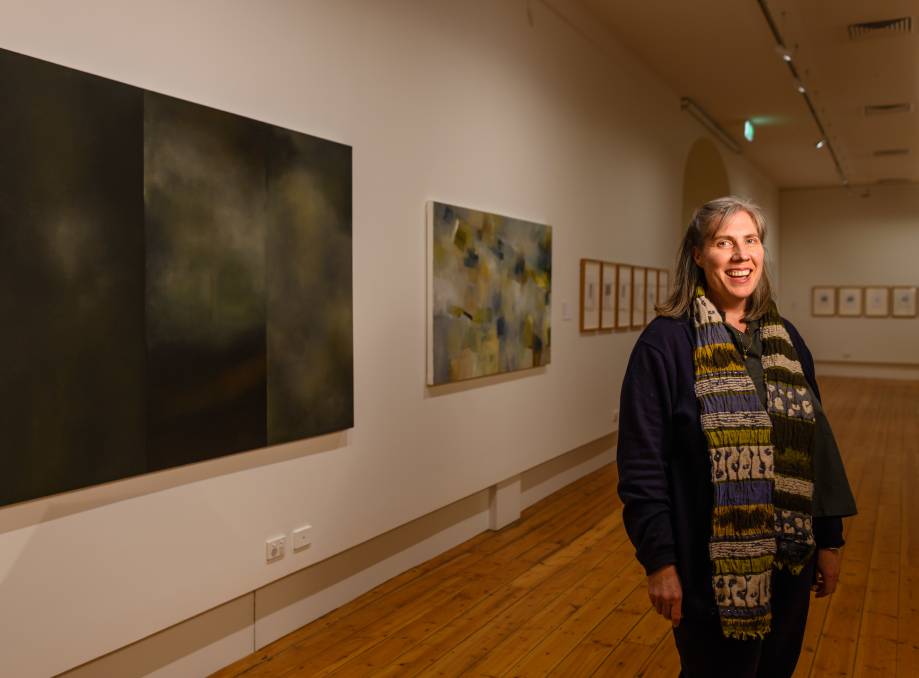QVMAG collection officer Ashley Bird with a circa 1860s Wedgwood vase from the decorative art collection.
Scott Gelston, Queen Victoria Museum and Art Gallery collection officers share their favourite items, The Examiner, 16 September 2018
Ashley Bird’s fascination with form and function has seen the Queen Victoria Museum and Art Gallery collections officer spend time exploring the institution’s vast storerooms.
In a role that allows the practicing visual artist to constantly be inspired, challenged and excited by all that the museum has on offer, Bird has relished his first 18 months in the role.
Hidden away at the Royal Park art gallery lies an extensive array of furniture, textiles, glassware and ceramics which form the backbone of their decorative arts collection.
The ceramics store is lined with racks of works by Tasmanian artisans, Australian masters and some historically significant pieces from around the globe, including a large collection of Wedgwood pieces from England.
With black gloves on, Bird meticulously removes a box from one of the racks, slowly strips away layers of tissue paper and shows off his favourite object – an 1860’s Jasperware copy of the Portland Vase.
The vase is based on an ancient roman cameo glass vase from between AD1 to AD25, which Wedgwood company founder Josiah Wedgwood set about reproducing at his Burslem factory, part of present day English city, Stoke-on-Trent .
Wedgwood succeeded in 1790, after four years of trial and error.
The fact the Launceston holds a Wedgwood piece of this quality genuinely excites Bird.
This blue Jasperware vase is slightly smaller than the original 1790 black reproduction, but none the less contains all the hallmarks of classic Wedgwood pieces. Upon looking through the collection at the art gallery, this piece immediately stood out to Bird.

“I’d seen many images of the original Wedgwood Portland vase with its classical Roman relief, but never seen the depth and dimension of the figures that made the Wedgwood sculptural relief and the Portland vase design in particular so important to the history of ceramics,” Bird said.
A new show highlighting some of the museum’s collection of Jasperware is now on show at the Royal Park site, with this particular vase providing the catalyst for Bird to curate the new display.
“I’ve always had an interest in this particular line of ceramics from Wedgwood, as a unique innovation that defined the brand and is still made today in the same method.”
In contrast to Bird’s 18 months in the role, fellow collection officer Bridget Arkless has spent the last 18 years working for the museum.
Having used her time cataloging pieces in the collection, procuring items for the museum and building relationships with local artists, Arkless has recently focused her attention on curating Robyn McKinnon’s first large scale museum exhibition.
The show covers McKinnon’s four decades as an artist, with both figurative and abstract pieces on display with paintings, drawings and object based artworks showcased for patrons to see.
McKinnon’s painting, First Basin 2000, is currently one of the dominant pieces on show in the Disappearing Into Being exhibition.
The large scale acrylic on canvas work was purchased by the museum in 2003, with Arkless personally selecting the work from the artist’s own studio collection.
“It is important for QVMAG to try and acquire the very best examples of the work by the most important Tasmanian artist of our time,” Arkless said.
“Robyn has an impressive command of the paintbrush, and the pencil.
“She has spent many thousands of hours working away in her studio creating a wide array of figurative and abstract paintings. Despite the domestic scale of her studio her ambition allows her to produce highly successful large-scale canvases such as this.”
Arkless’s love of abstract works and the deeper meaning they convey has drawn her back to this particular piece time and again.
“I am especially drawn to this painting because it encapsulates the mystery and beauty of the First Basin, which was an important Aboriginal meeting place prior to European settlement, but is today loved by all of us for its natural beauty.”
Jasperware is on show in a semi-permanent exhibition on level one of the Royal Park art gallery.
Disappearing Into Being is on show until November 11th on the ground floor of the Royal Park art gallery.
The gallery is open daily from 10am to 4pm.

